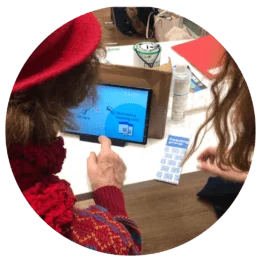
We experimented with the position of the QR code on the ticket so it was easier to scan in the app. In the latest iteration, we designed the ticket to be more compatible with the tablet stand so that the alignment of the QR code was more intuitive. The ticket also evolved to be more printer friendly (designed in an A4 page format and requiring minimal ink).
The initial prototype contained key information to join the call, with a simple photo to aid association with the group and a large QR code to scan.

We included our app icon and created a background of arrows so that when people viewed the ticket through the camera lens, they could follow the arrows to the QR code.

In this iteration, we turned the QR code into a background pattern so that people could easily scan it no matter where they focused the camera on the ticket.

We simplified the design whilst strengthening its function, making it reminiscent of a train ticket with the shape helping to support users to insert it in the stand with the correct orientation.

Initially, we created a paper template (a combination of a stand and a ticket) that people could hold their tablet over and guided them through the process, including how to scan the QR code. When we tested this at a community group, participants were unable to focus on the template, so the idea evolved into a stand that could hold the Zoom Ticket in the correct position for the QR code to be scanned. The final stand is a flat pack made from cardboard. We developed a template to make the stands for the pilot by hand.
The initial design started with a tablet template onto which people could place the device and see an explanation of the button functions. The QR code was scannable when the tablet was lifted.

Due to people struggling to lift the tablet, we tested how well a physical stand would work instead. One challenge of fixing the tablet location was getting the ticket at the right distance so the camera could focus and scan it.

We incorporated instructions in the stand and on the tablet home screen so people could follow the steps seamlessly between the physical and digital worlds. We created a fixed back to the stand that enabled people to place the Zoom Ticket at the correct distance from the camera for easy focusing and scanning.

In the final prototype, we added colour to the instructions to create greater contrast. We also added velcro tabs to the sides of the stand so it was easily constructed from flat pack format and added an image indicating where the ticket should be inserted at the back of the stand.

Initially, we experimented with off-the-shelf QR scanner apps but then decided that creating a bespoke, simpler app with no adverts or distractions and context-relevant prompts would significantly increase the success of the kit.